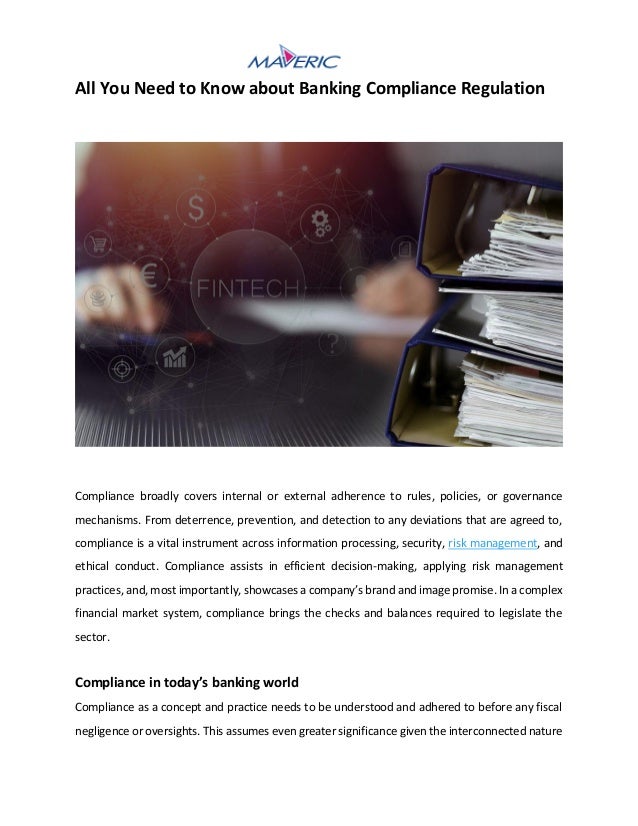
All You Need to Know about Banking Compliance Regulation.pdf
- 1. All You Need to Know about Banking Compliance Regulation Compliance broadly covers internal or external adherence to rules, policies, or governance mechanisms. From deterrence, prevention, and detection to any deviations that are agreed to, compliance is a vital instrument across information processing, security, risk management, and ethical conduct. Compliance assists in efficient decision-making, applying risk management practices, and, most importantly, showcases a company’s brand and image promise. In a complex financial market system, compliance brings the checks and balances required to legislate the sector. Compliance in today’s banking world Compliance as a concept and practice needs to be understood and adhered to before any fiscal negligence or oversights. This assumes even greater significance given the interconnected nature
- 2. of global banking businesses today, where organizations spread across borders are subject to various ethical and moral implications. Due to the latest consumer credit crisis and high-profile compliance breakdowns (like three leading Belgian banks – ING Belgium, KBC, and BNP Paribas Fortis alleged to be money laundering sums around $2T), various state and central regulatory agencies have increased their watch across consumer practices and regulatory reporting. Even the general public today is more aware of the standard concepts of litigation, financial penalties, and regulatory constraints. Basel Standards After the financial crisis of 2007-09, an internationally agreed set of measures was developed by the Basel Committee on banking supervision. The Basel framework was brought into action to protect the sector from recession and insulate the financial system and real economy from adverse effects. Pillar I – Enhanced minimum capital requirements (governs calculations for Credit, market, and operational risk) Pillar II – Supervisory review process (controls capital for all risks associated with the business) Pillar III – Disclosure and discipline (regulates the disclosure of risk, capital, & risk management) Fundamental compliance dynamics for the banking industry 1. Continuously changing international and European level regulations. This puts a severe strain on the limited number of staff in the compliance department for small and mid-size financial institutions. 2. Risk management. Most risk functions are pressed to be open to enable innovation and maintain optimal costs. Basel III framework brings detection, measurement, and risk reporting under the scanner. 3. Money laundering. Given the rise of cyber terrorism and large-scale geo-conflicts, the menace of money laundering is active and pernicious. The liabilities of banks are at a continual high. 4. Risk Reporting. Depending on business and geography, every bank (basis jurisdiction) has different reporting standards, making the entire scenario complex.
- 3. 5. GDPR requirements. Data storage, personal information, and management are pertinent debates to today’s risk and compliance narrative. Consequently, matters of trust and customer engagement have a direct implication. 6. Regulatory perimeter. As the name suggests, banking activities outside the federal bank regulatory perimeter are addressed at the state and local levels. The model faces pressure with the latest advances in decentralized finance like cryptos. 7. Third-party risk management (TPRM). Third-party risk management is a bedrock of non-financial risk for banks. Regulators understand that with the expansion of the banking ecosystem, various parameters (agility and responsiveness, consolidation, and growth) need to be understood differently. 8. Data infrastructure and technology resilience. There is nothing more vital than data to identify and manage emerging risks. The development of risk mitigation responses depends on the robustness of integrating data and legacy systems, analytics abilities, and overall resilience. 9. Governance and core risk management. With the WFH and hybrid work scenario increasing, foundational risk management, governance expectations, and strong internal controls must be implemented and operationalized. Conclusion Compliance is today a core business for banks. Top management must provide role models for the functions and present perspectives for the rest of the company. Awareness, training, and regular conversations across the C-Suite and entry-level workforce on emerging compliance scenarios are vital to the smoother integration of theory to practice in the workplace. Original Source: https://maveric-systems.com/blog/all-you-need-to-know-about-banking-compliance- regulation/
